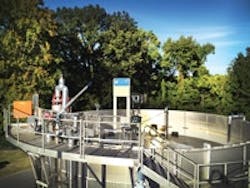About the author: Art Savage is regional sales manager for Landia Inc. Savage can be reached at [email protected] or 919.466.0603.
Oklahoma-based World Water Works (WWW) joined regional wastewater treatment utility Hampton Roads Sanitation District (HRSD) in a private-public partnership to successfully install a centrifuge centrate treatment process—used previously only in Europe.
A submersible mixer is helping WWW at North America’s first operating implementation of the DEMON (an acronym for deammonification) sidestream deammonification process, which removes nitrogen from wastewater containing high ammonia concentrations (greater than 200 mg/L).
WWW, which holds exclusive licenses from DEMON GmbH for applications in the U.S. and India, specializes in developing, designing and manufacturing efficient process and wastewater solutions. These designs emphasize delivering clean water while recovering energy and other resources.
Designed to agitate, homogenize and suspend solids in demanding conditions, Landia’s submersible mixer model POP-I is utilized to mix granulated sludge for WWW’s DEMON process at York River Treatment Plant, located in Seaford on Virginia’s coastline.
Deammonification, which is partial nitritation by ammonia oxidizing bacteria (AOB) combined with anaerobic ammonium oxidation (anammox), provides up to 70% to 90% total nitrogen removal. It also results in a 50% reduction in alkalinity requirements (compared with traditional nitrification-denitrification), a 65% reduction in aeration energy, and a 100% reduction in supplemental carbon. Unlike conventional and typically costly nitrification-denitrification methods for removing nitrogen, which require large amounts of energy and methanol, the process’ AOB and anammox efficiently and effectively remove ammonia from wastewater. This anammox-based deammonification system uses 60% less energy and completely eliminates the need for methanol. It also produces
90% less sludge than conventional systems. Along with reducing costs, the anammox-based process features a low carbon footprint because it sequesters carbon dioxide.
Combining Technology
The DEMON process provides system resilience and lessens the need for oversight and maintenance. It is one of several available forms of single-step (in the same tank) partial nitritation-anammox designed for centrate treatment from anaerobically digested biosolids and operated as a sequencing batch reactor (SBR).
Featuring a propeller that is shaped for flow/homogenization, the POP-I mixes the anammox biomass in a versatile on/off operation, kicking in automatically for the non-aeration cycle.
“High concentrations of ammonia in effluent present a continuing problem for municipal wastewater plants and many industrial facilities,” said Daniel Dair, regional technical manager for WWW. “As part of the solution we provide, Landia’s mixer is very adaptable, as well as proving highly effective and reliable for the DEMON process. We also get good support from Landia.”
“We handle a wide range of mixing applications, ranging from thin liquids to very heavy sludge,” said Soren Rasmussen, director for Landia. “The process is one of several interesting technologies that World Water Works offers. We also supply low-speed mixers for [its] moving bed biofilm reactors [MBBR], where we agitate the plastic biofilm carriers in anoxic MBBR tanks. It’s these types of unique mixing applications that make it fun to be a mechanical engineer in the wastewater industry, plus WWW is a very enjoyable company to work with.”
While this process had been applied at approximately 40 plants in Europe, it had not been implemented elsewhere in a full-scale application. This was primarily because of the requirements for seeding the process using imported biomass from European operating facilities.
The process was originally developed and patented by the University of Innsbruck in Austria.
Successful Application
The York River Treatment Plant currently includes a fully aerobic nitrifying activated sludge system with post-denitrification filters.
In 2002, HRSD launched Virginia’s first municipal water reuse project at Seaford, which required the construction of an SBR. The initiative ended, however, when an adjacent refinery, the only reclaimed water customer, closed. Consequently, during recent plant upgrades, the SBR and equalization tanks installed to support the reuse project were retrofitted to serve for centrate equalization and full nitrification. This meant that only minor piping needed to be carried out to install the deammonification, making the project more affordable and sustainable.
The process was seeded with 5,000 gal of concentrated anammox biomass by mixing the imported anammox biomass with plant effluent. After some minor modifications to the equalization tank, the process soon achieved operating objectives for ammonia loading and total nitrogen removal.
Serving 17 localities in southeastern Virginia, HRSD was created by public referendum in 1940 to eliminate sewage pollution in the tidal waters of Chesapeake Bay. HRSD owes its creation to oysters, a robust seafood industry in the early 1900s: The Virginia Department of Health condemned a large oyster-producing area in 1925, bringing the question of sewage pollution firmly into the spotlight.
As the region has grown and its needs expanded, HRSD has remained dedicated to protecting and enhancing the environment, maintaining an enviable record in the wastewater industry. Residents of its communities in Virginia are able to fully enjoy the benefits of the local waterways.
Download: Here
